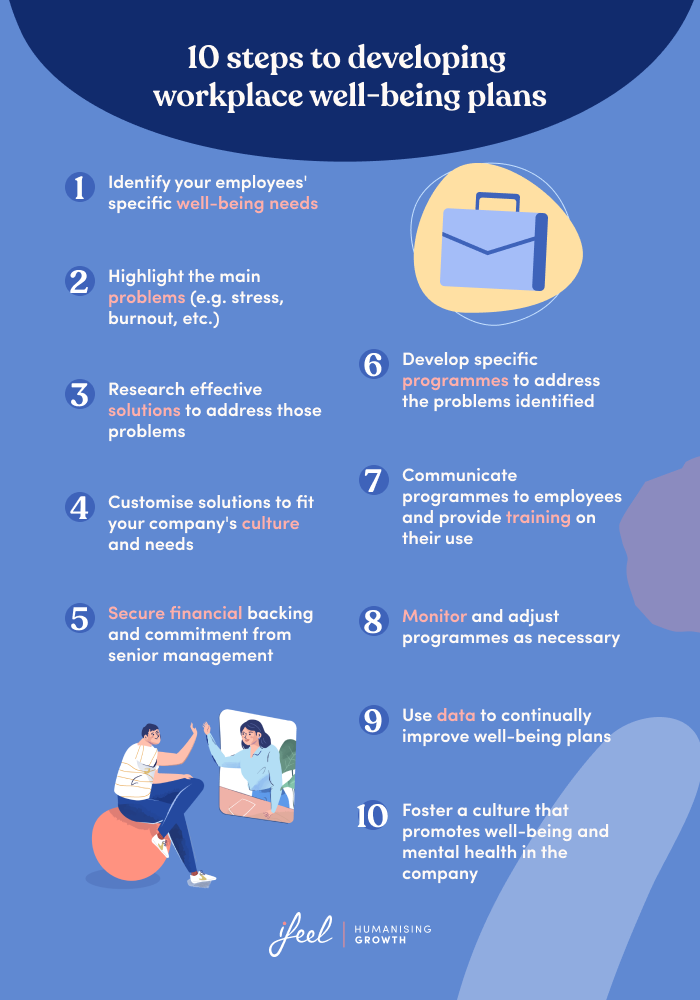Employee wellness programs are the result of a decision-making process by corporate managers aimed at protecting and supporting their employees’ psychological health. Read more about it in this post.
Why have employee wellness programs in companies?
For two main reasons. The first is that employee wellness programs are very useful tools that are in line with the data that has been available for years indicating that the psychological well-being of employees improves their overall performance. Secondly, employee wellness programs allow companies to comply with legal obligations regarding the detection and prevention of psychosocial risk factors that may be affecting team members.
Each organization can have a wellness program that best suits the characteristics and needs of its employees. It is a matter of having tools that make it possible to assess the work environment, identify and evaluate psychosocial risk factors, work motivation, and tools that are adaptable and assessable on a regular basis to adjust to the current stage of the company’s life cycle.

How to design employee wellness programs?
When it comes to providing psychological well-being protection measures in the form of employee wellness programs, we tend to focus on the most common psychological health issues in the workplace.
At number one would be anxiety and stress, which are two great realms in themselves and could be the subject of several articles, but which, for the same reason, are very unspecific and therefore tend to be neglected.
When naming the classics, we cannot forget about burnout syndrome, as a set of signs and symptoms that cause an employee to lose their motivation, saturate their creativity and disrupt their commitment to the task and the company.
However, what about the problems related to boreout and the influence of motivation, commitment, identification/belonging, talent development, participation…?
All these and others are also aspects that have an impact on the psychological well-being of employees. In other words, we must make an effort and go further when it comes to planning employee wellness programs that are appropriate for these specific companies.
This implies adopting a proactive, demanding, and non-accommodating attitude on the part of those responsible for non-conformism or over-indulgence: beware of thinking that things are apparently going well, or believing that they are going well just because nobody says otherwise, or because nobody has left the company early (yet), or because we have not (yet) had legal or health problems (sick leaves) for issues related to mental health, discrimination, harassment at work, sexual harassment at work…

Join the global leading solution in mental well-being
5 characteristics of employee wellness programs in companies
There are no magic formulae to design employee wellness programs in companies that are suitable for any company in any context. However, we have outlined 5 general characteristics that a wellness program for any organization should have and must be put into action.
| Characteristics of employee wellness programs | |
| Specificity | It is a matter of identifying this particular company’s main psychosocial risk factors. To do this, it is essential to know the workforce, to be aware of their characteristics, and to keep useful communication channels open. This will enable those responsible for well-being at work to be familiar with the needs and characteristics of the employees to make efficient decisions that can meet them. |
| Combining prevention with outreach | At work, as in all other aspects of life, some things can be prevented and others, unfortunately, have to be dealt with as they arise so that they do not generate major complications in organisational well-being (also known as corporate well-being). Keeping this in mind will be of great help when designing a mental well-being plan in the company to avoid the appearance of problems and to deal with those that it has not been possible to prevent. |
| Realistic approach | Designing employee wellness programs involves taking a stance on employee health and a certain degree of ambition about achieving goals in this regard. However, it is important to be clear about the limits of corporate responsibility when talking about psychological well-being, without aiming for the impossible or for things that fall outside the corporate sphere (such as happiness, for example, or the personal fulfilment of employees), however noble these goals may be. |
| Flexibility | Not everything works for everyone all the time. Well-being plans in companies cannot be effective if they do not have a regular evaluation mechanism that allows them to measure their results, make adjustments, and adapt the company’s decisions to the particular moment that its employees are experiencing. Stability is good for psychological well-being, but not rigidity. |
| Coherence | Three aspects should be taken as a guide when designing well-being plans for companies. Firstly, the information available on the characteristics and needs of the workforce. Secondly, the corporate purpose and mission of the company. Finally, the values reflected within the explicit corporate culture and known to all employees. Without coherence between these points it is impossible to start a good corporate well-being strategy, no matter how valuable the social benefits employees receive are. It is better to do less, but with honesty, than to say we will do a lot and then nobody knows what is being done or to do something very showy, but nobody understands why. |
1. Specificity
It is a matter of detecting the main psychosocial risk factors for a particular company. To do this, it is essential to know the workforce, to be aware of their characteristics, and to keep useful communication channels open. This will enable those responsible for workplace well-being to be familiar with the needs and characteristics of staff members and make efficient decisions in order to meet them.
2. Prevention combined with approach
At work, as in all other areas of life, there are things that can be prevented and others that, unfortunately, must be dealt with as they emerge so that they do not cause major complications in corporate well-being. Keeping this in mind will be of great help to avoid the emergence of problems and to deal with those that could not be prevented.
3. Realism
The design of employee wellness programs in companies implies a stance on employee health and a certain degree of ambition about the objectives to be achieved in this area. However, it is important to be clear about the limits of corporate responsibility when talking about psychological well-being and not to expect the impossible, things that are outside the scope of the corporate sphere, such as happiness or personal fulfillment of people, however noble they may be.
4. Flexibility
Not everything works for everyone all the time. Employee wellness programs cannot be effective if they do not have a periodic evaluation process to measure results, make adjustments and adapt decisions to the particular situation of the company’s employees. Stability is good for psychological well-being, but rigidity is not.
5. Coherence
When developing employee wellness programs for companies, we must take three aspects into account as a guideline. First, the information available on the characteristics and needs of the workforce. Secondly, the company’s mission statement and corporate purpose. Finally, the values reflected in the corporate culture are clear and known to all employees. Without consistency between these points, it is not possible to start a good employee wellness strategy, however valuable the social benefits received by employees may be. It is better to do less, but honestly, than to say we will do a lot and then nobody knows what is being done, or to do something very attractive but nobody understands why.

Emotional well-being for companies
At ifeel, we understand that it is not possible to take care of the company without taking care of the psychological well-being of its employees. To do so, we have an emotional well-being program for companies, designed by our team of occupational well-being psychologists with one main objective: to help companies place employee health at the center of their strategy to build their mission statement.
Thanks to this partnership, the people in charge of HR departments can receive personalized, data-driven advice on how to make good decisions in a company to get the most out of the teams they are in charge of and take better care of the psychological well-being of the people in them.
Moreover, this program offers employees a holistic mental health care service structured at different levels according to their needs. This service includes, if required, online psychological therapy with a psychologist specialized in cases like theirs. Try our program today so you can see how it could help you.
We hope you found this post about employee wellness programs useful. If you want more information about our emotional well-being program for companies, simply request it and we will contact your team as soon as possible.










